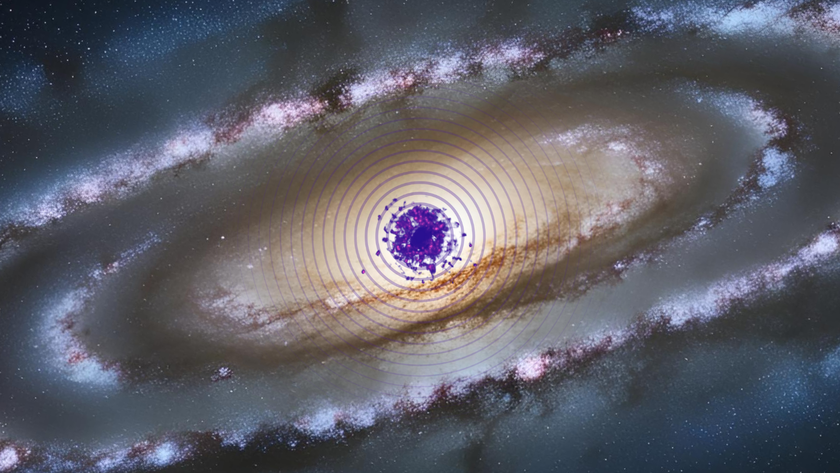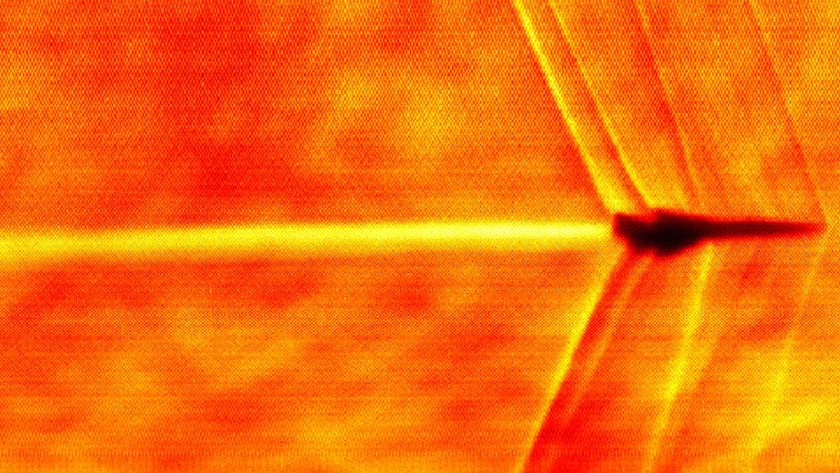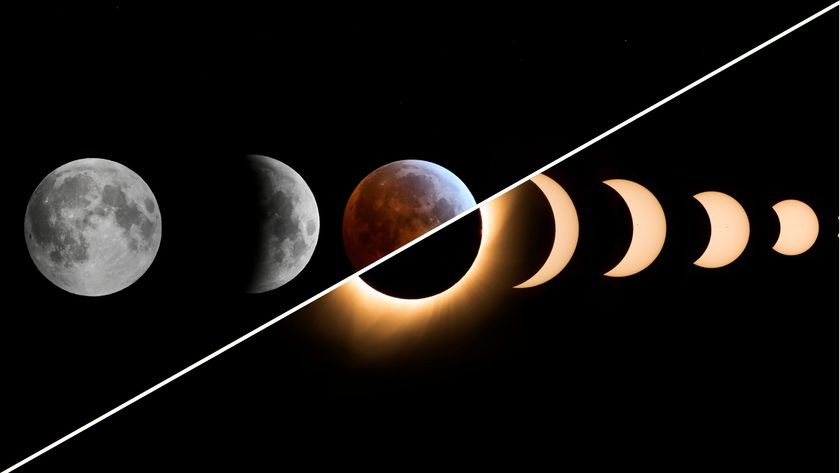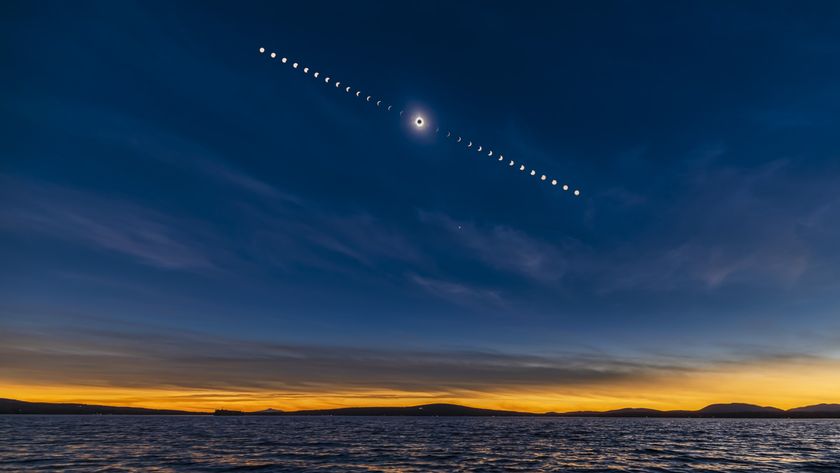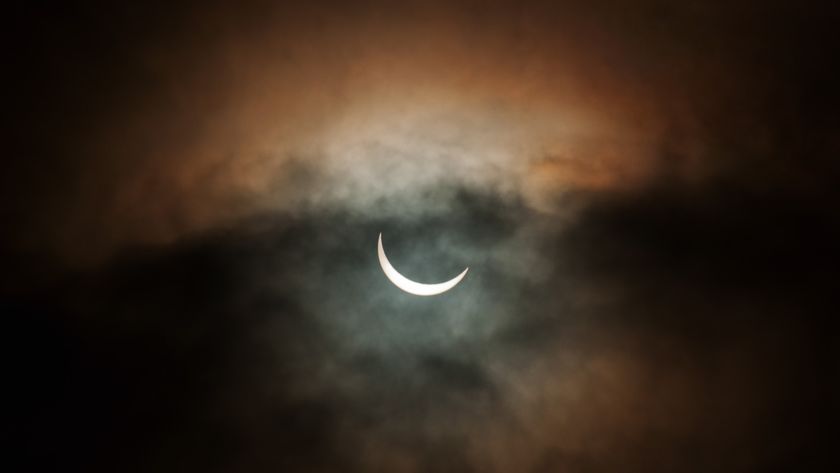Betelgeuse: A guide to the giant star sparking supernova hopes
When Betelgeuse explodes in a supernova, it will shine as bright as the full moon in our sky.
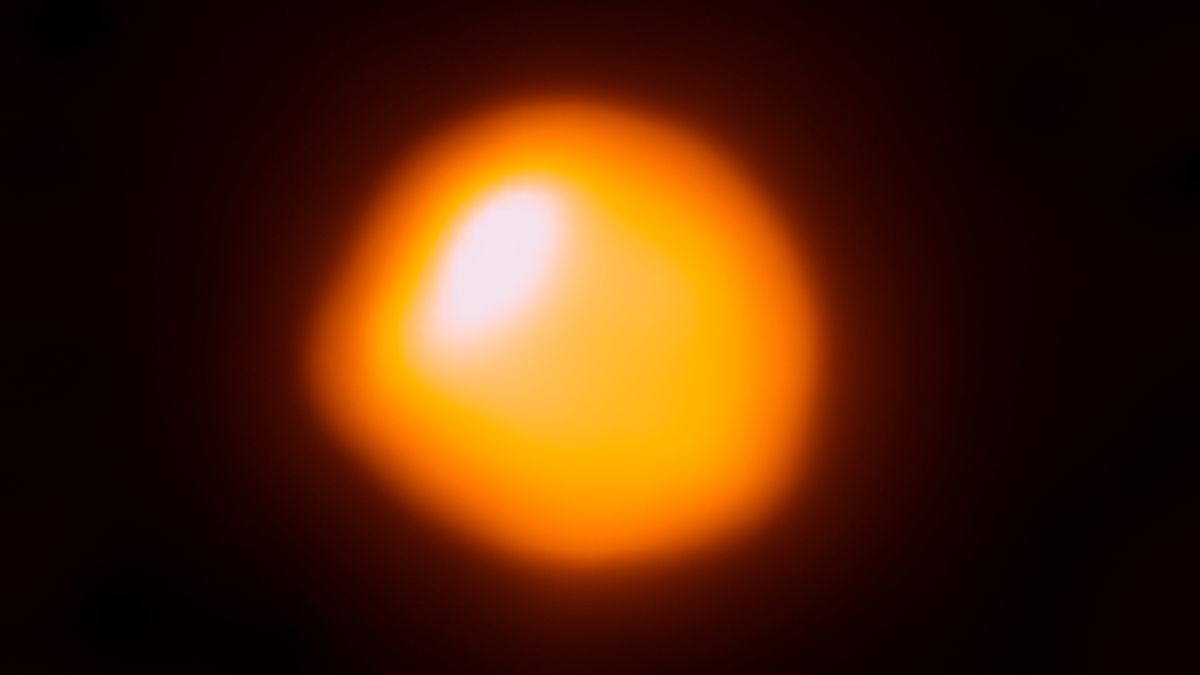
Betelgeuse is one of the brightest stars in the night sky and also one of the largest stars known to astronomers.
Forming the left shoulder of the constellation Orion, Betelgeuse is a so-called red giant, a star in the final stages of its life, which sometimes prompts speculations that it might soon explode in a supernova.
Located some 650 light-years from Earth, Betelgeuse, also known as Alpha Orionis, usually ranks as the tenth brightest star in the night sky. The star, however, is known for its periodic dimming and brightening up, which sometimes makes it climb a bit up or down the ranking.
Astronomers think that Betelgeuse is only 10 million years old, that's 50 times younger than our sun. Despite its relatively young age, Betelgeuse has already run out of the hydrogen fuel in its core and is now in the final, red giant stage of its life, fusing helium to carbon.
Related: A guide to the brightest stars in the sky
Betelgeuse's life cycle
The reason for Betelgeuse's fast-paced life is the fact that it was likely born very massive. According to ScienceAlert, Betelgeuse used to be a blue-white O-type star, the most massive kind of main sequence, hydrogen-burning star. The bigger the star, the brighter it shines and the hotter it burns. But also the faster it runs out of its hydrogen and the sooner it turns into a red giant.
In its prime, Betelgeuse must have been tens of times more massive than our sun and tens to hundreds of times more luminous. Temperatures on its surface may have reached up to a mind-boggling 89,500 degrees Fahrenheit (50,000 degrees Celsius), compared to the sun's "lukewarm" 10,000 degrees F (5,500 degrees C).
After Betelgeuse exhausted its hydrogen and began burning helium, its envelope expanded far beyond its original size. Today, Betelgeuse is one of the largest known stars, measuring more than 700 million miles (1.2 billion kilometers) in diameter. If Betelgeuse were to replace the sun at the center of the solar system, it would reach all the way to Jupiter. On the other hand, the star is no longer anywhere near as hot as it used to be. At 5,800 degrees F (3,300 degrees C), Betelgeuse's surface is now cooler than that of the sun. Still, the star shines 7,500 to 14,000 times brighter than our star, according to NASA.
| Header Cell - Column 0 | Betelgeuse | The sun |
|---|---|---|
| Diameter | 700 million miles (1.2 billion km) | 870,000 miles (1.4 million km) |
| Age | 10 million years | 4.6 billion years |
| Surface temperature | 5,800 degrees F (3,300 degrees C) | 10,000 degrees F (5,500 degrees C) |
| Distance from Earth | 650 light-years | 94 million miles (151.8 million km) |
Due to its enormous size and relative proximity to Earth, Betelgeuse is one of the very few stars that can be studied in greater detail by telescopes on Earth and in its orbit, Morgan MacLeod a postdoctoral fellow in theoretical astrophysics at Harvard University who studies the star, told Space.com
"Most stars other than our sun cannot be studied in any detail at all," MacLeod said. "We see them only as point sources of light. But Betelgeuse is big enough that we can resolve it with the Hubble Space Telescope and with radio telescopes."
Those images reveal a striking body quite unlike our sun. Rather than a single smooth sphere of superhot plasma, Betelgeuse is a lumpy clump of boiling gas bubbles, some of them as large as a small star. Huge plumes of hot material rise from Betelgeuse's core to its surface, then cool down and disappear back inside the interior. It's like the sun's cycle on very high doses of steroids.
Related: Odd supergiant star Betelgeuse is brightening up. Is it about to go supernova?
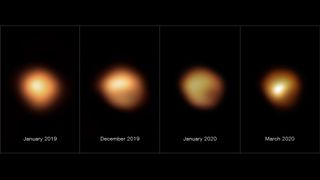
Betelgeuse's Great Dimming
In recent years, Betelgeuse has been making headlines as its behavior has become somewhat erratic. For centuries, astronomers have observed Betelgeuse's brightness to wax and wane on a regular 400-day cycle, rising to the magnitude of 0.3, then dimming to about 0.8 (magnitude is a measure of a star's brightness that is logarithmic and inversely proportional to the actual observed brightness, so the lower the number, the brighter the object. For example, at its brightest, the planet Venus shines with a magnitude of about -4.6).
But in December 2019, the star had suddenly gone 2.5 times fainter than what had ever been seen before. The cause of the event, since dubbed the Great Dimming, was later traced to an enormous expulsion of material from the star's interior that created a huge dust cloud that subsequently obscured our view of the star.
Although the dust cloud has since dissipated and Betelgeuse has regained its usual brightness, the star has not been quite its old self since. Its 400-day brightness oscillation period has halved to 200 days and, on top of that, in the spring of 2023, the star began to brighten beyond its usual peak luminosity.
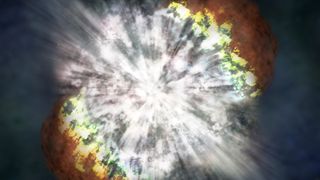
Betelgeuse supernova
Betelgeuse's antics prompted speculations that the star might soon explode in a supernova. Supernova explosions are the swan song of very massive stars. After they consume all of the helium in their cores, red giants begin to burn carbon and oxygen into neon and magnesium, then burn those into silicon. Eventually, the stars' cores fill with iron. And that's when the fireworks begin.
"Adding helium nuclei to an iron atom actually extracts energy rather than gives off energy," said MacLeod. "So all of a sudden, rather than a reaction which is releasing tremendous amounts of energy, the center of the star starts to absorb energy. And when that change happens, the center of the star collapses on itself kind of from the inside out, and then that leads to what we call the core-collapse supernova."
Supernova explosions are so bright that they briefly outshine entire galaxies. With current sensitive telescopes, astronomers can spot supernovas in the farthermost reaches of the universe. Multiple such explosions can be detected within a single night, but most of them are so far away that we mere mortals can't notice.
A Betelgeuse supernova would be different. Due to the star's close proximity, the explosion would be so bright that it would be visible even in the daytime.
"When it happens, the star will become as bright as the full moon, except that it will be concentrated in a single point," Miguel Montargès, a postdoctoral fellow at the Laboratory of Space Studies and Instrumentation in Astrophysics at the Paris Observatory and Betelgeuse expert, told Space.com. "For maybe two months, it will be so bright that if you shut down all the lights in a city and have no clouds, you would be able to read a book in the light of the supernova."
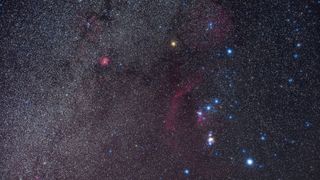
How likely is Betelgeuse to go supernova in our lifetime?
With a promise of such a spectacle, it is no surprise that skywatchers wish for Betelgeuse to die. The last time a massive star went supernova in our galaxy, the Milky Way, was in the era of the famous astronomer Johannes Kepler. The SN 1604 supernova, also known as the Kepler supernova, shone brightly in the day sky for three weeks, according to historical records,
But most astronomers who study Betelgeuse temper the expectations. According to the most accepted models, the star is only in the early stages of its red giant life, happily fusing helium, and still tens of thousands of years away from going boom.
"The helium-burning phase is several hundred thousand years long," Montargès said. "Then you have the next phase that lasts like 10,000 years, then thousands of years, and then it's a century, and the final one is only some days and hours just before the explosion."
While Betelgeuse is close enough for astronomers to study the chemical composition of its atmosphere, no existing instrument can peer inside the star's core to see whether it's really fusing helium or had moved on to fusing carbon and oxygen already. Most of the assumptions about Betelgeuse's state are therefore based on observations of other red giant stars, Montargès said
For example, another Milky Way red giant known as VY CMa, located 3,900 light-years away from Earth in the constellation Canis, is thought to be much closer to the moment of its death than Betelgeuse. But unlike the bright Betelgeuse, that star has been consistently dimming over the past 100 years.
"A hundred years ago, VY CMa used to be visible to the naked eye," said Montargès. "But it has expelled so much material that we can now only see it in infrared. This expelling of material is what we expect to see when the star nears the supernova explosion. VY CMa has already removed about 60% of its original mass, while Betelgeuse still has 95% of its initial material."
The astronomer added that, according to historical records, Betelgeuse used to be described as a yellow star up until 2,000 years ago, when poets began describing it as red. That, Montargès thinks, might indicate that Betelgeuse is only in the earliest stages of its life as a red giant.
How to observe Betelgeuse
The tenth brightest star in the sky, Betelgeuse is easy to find and easy to observe even from the most light-polluted cities. The Orion constellation graces the night sky in the winter months on both the Northern and Southern Hemispheres. The constellation's most distinct feature is the belt formed of three bright stars. Above them sits the triangle of what is supposed to be Orion's head and shoulders. The reddish star on the left is Betelgeuse, the constellation's second-brightest star.
Betelgeuse FAQs answered by an expert
We asked astrophysicist Morgan MacLeod a few commonly asked questions about Betelgeuse.

Morgan MacLeod is an astrophysicist at the Harvard-Smithsonian Center for Astrophysics. He studies stars and star systems using computational modeling and simulation methods.
Why is Betelgeuse interesting for astronomers?
Betelgeuse is an amazing star. It's one of Orion's shoulders and so when we look up at the constellation Orion, it's right there in front of us. Most stars other than the sun we don't get to actually see in any detail, we just see them as point sources of light. But Betelgeuse is big enough in our sky that we can resolve it with the Hubble Space Telescope and with radio telescopes. And what we see in those images is that the star is lumpy. It's not a perfect sphere. It's this lumpy boiling thing, and the size of those lumps is similar to the size of a star.
We see that there is powerful convection going on inside Betelgeuse. The entire star is essentially boiling in an extreme way. We see convection on our sun but the sun's convective cells are really small compared to the sun's size. With Betelgeuse, this boiling is on a completely different scale.
Do you think Betelgeuse is going to go supernova any time soon?
Our best models indicate that Betelgeuse is still a relatively long time from eventually exploding. So we're talking about tens of thousands or maybe a hundred thousand years, if those models are correct.
In other stars that went on to explode in supernovas we have seen similar phases that we see in Betelgeuse. There were outbursts of brightening and dimming, which suggests that this incredibly strong and violent convection that we're seeing in Betelgeuse is part of the lead-up to a supernova explosion in some red supergiant stars.
But we also think that it may be going on for quite some time before the star gets to that explosion. And one of the questions that astronomers would love to know the answer to is whether there are any telltale signs that a star is one year from exploding into a supernova, a decade or 1,000 years? And right now, we just don't know. But that's part of why we're studying Betelgeuse in so much detail, because we think it is an example of the sort of star that does go through that evolutionary path and it is the closest example [of such a star] and so we have this chance to resolve its structure on the sky and study it in incredible detail.
What do you know about Betelgeuse's Great Dimming?
The dimming in 2019 was the most significant in the more than 100 years that astronomers have been keeping track of Betelgeuse's brightness. The star became dimmer for a period of a few months and then it brightened again to close to its normal levels. But after that, we noticed that the star's usual pulsation period changed from 400 days to 200 days.
We wanted to understand the connection between those two events. So we studied that process with a computer simulation and we found out that most likely, inside Betelgeuse's boiling interior, two really big blobs of fluid ran into each other in a particularly dramatic way that happens only once in perhaps a century. And that collision sent a huge amount of material to the surface and drove shockwaves ahead of it. And when that blop of material reached the surface, some of the material burst out from the surface, but at the same time, the interior began falling back in. So essentially, the outside and the inside of the star got out of sync with each other and we think that this caused the change of the pulsation period.
What do you expect to happen with Betelgeuse in the coming years?
We think that it will return to its regular 400-day cycle of dimming and brightening in the next five to ten years.
Additional resources
Watch this brief European Space Agency video about Betelgeuse. Here you can see some stunning images of Betelgeuse taken by the European Southern Observatory's Very Large Telescope. This animation shows how Betelgeuse changed its brightness during the Great Dimming.
Bibliography
Wheeler, J.C., Chatzopoulos, E. Betelgeuse: a review, Astronomy & Geophysics, Volume 64, Issue 3, June 2023
https://doi.org/10.1093/astrogeo/atad020
Davis, K. Alpha Orionis (Betelgeuse), American Association of Variable Star Observers, accessed, June 2023
https://www.aavso.org/vsots_alphaori
Montargès, M. et al. A dusty veil shading Betelgeuse during its Great Dimming, Nature, June 2021
https://www.nature.com/articles/s41586-021-03546-8
MacLeod, M. et al. Left Ringing: Betelgeuse Illuminates the Connection Between Convective outbursts, Mode switching, and Mass Ejection in Red Supergiants, Arxiv, May 2023
Join our Space Forums to keep talking space on the latest missions, night sky and more! And if you have a news tip, correction or comment, let us know at: community@space.com.
Get the Space.com Newsletter
Breaking space news, the latest updates on rocket launches, skywatching events and more!

Tereza is a London-based science and technology journalist, aspiring fiction writer and amateur gymnast. Originally from Prague, the Czech Republic, she spent the first seven years of her career working as a reporter, script-writer and presenter for various TV programmes of the Czech Public Service Television. She later took a career break to pursue further education and added a Master's in Science from the International Space University, France, to her Bachelor's in Journalism and Master's in Cultural Anthropology from Prague's Charles University. She worked as a reporter at the Engineering and Technology magazine, freelanced for a range of publications including Live Science, Space.com, Professional Engineering, Via Satellite and Space News and served as a maternity cover science editor at the European Space Agency.
- Elizabeth HowellFormer Staff Writer, Spaceflight (July 2022-November 2024)

